The events around Sunday, 28 September 2014, when the police repeatedly used tear gas against peaceful student protesters in Admiralty and Central are well documented, as are the days after, when Hong Kong appeared on the radar of a larger international audience, with even James Nachtwey, a veteran photojournalist who made his name on the streets of Thailand, Iraq and Northern Ireland being spotted on the streets of Hong Kong.
But this movement wasn’t expected, it wasn’t even planned. It took the organizers almost as much by surprise as the police, and most of all it caught the international media completely off guard who were almost completely unrepresented until students were being met with tear gas. Sadly they can now only speculate to what galvanized a student strike into an internationally recognized popular movement.
I would like to add my own account of the events between September 25 and 28, which I find crucial to understanding the movement’s origins.
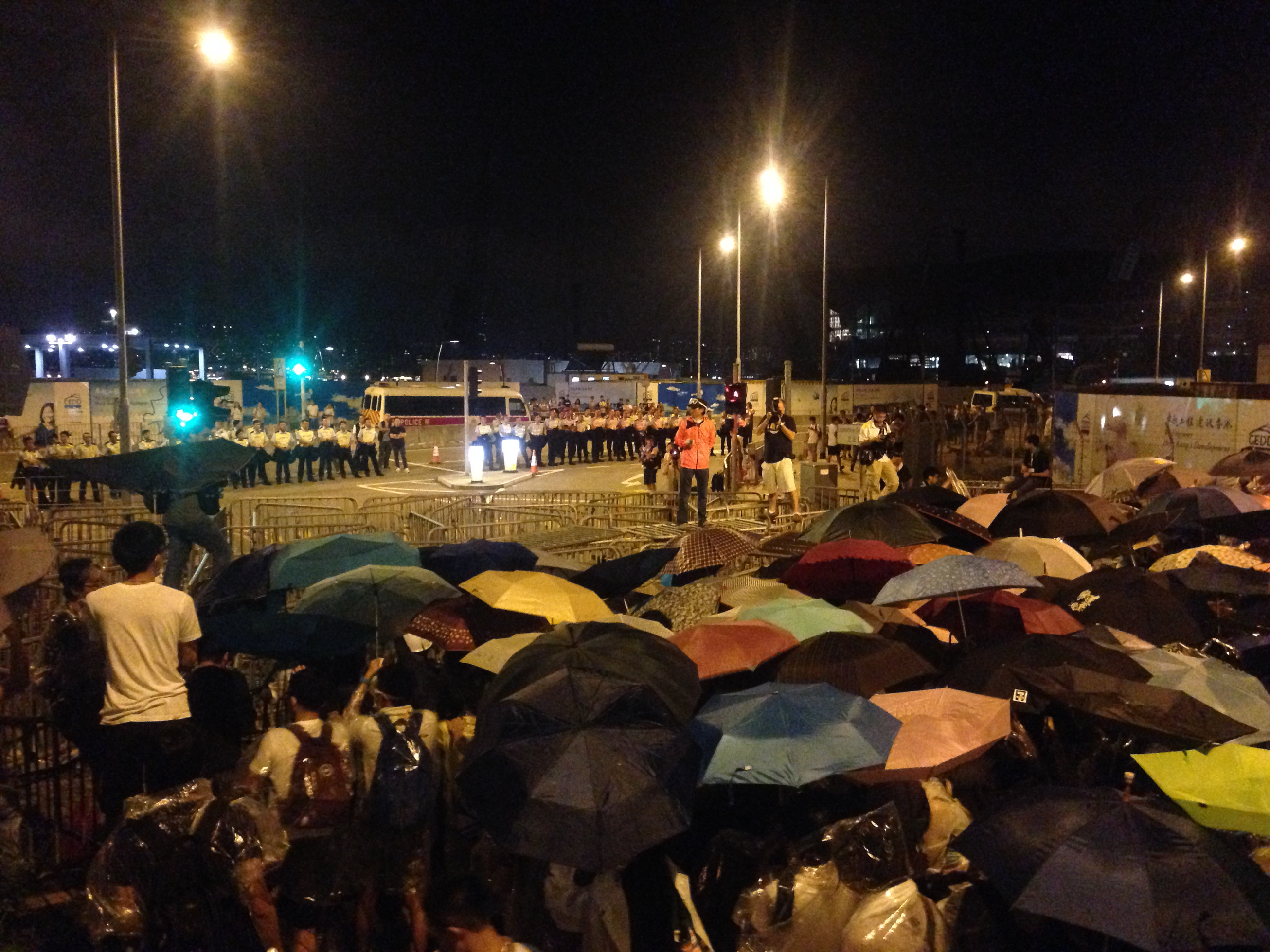
A student leader giving a motivational speech ahead of an expected standoff with police
The tertiary student’s strike began officially on Monday, September 22 with a rally at the Chinese University in Sha Tin. About 13,000 students showed up [AP] [NYTimes] without any interference or notice from the government or the police. This event coincided with Hong Kong’s most wealthy tycoons kowtowing to Xi Jinping in Beijing [WSJ].
The strikes themselves didn’t go very well in terms of student participation. While academics largely supported the students mentally and argumentatively, lectures did go on and the attendance rate was in many fields quite high. Few understood how going to Tamar Park every morning would pressure the government to back down or even alter their proposal for “fake” universal suffrage, as it is being labelled.
The impression that the students gave to media and many citizens was that of a happy camping in the park, listening to lectures without the pressure of credits, class participation or exams. Worthless in the eyes of many, even students.
Tuesday and Wednesday went by like that relatively uneventful, and the student’s demand to talk to Leung Chun-ying was almost unnoticed by the public. It is ironic that the government was only agreeing on talks once the road blockades had been well established, and then called them off again a few days later because of the illegal road blockades when students desired to speak to the government well before their “illegal actions”.
Thursday, 25 September 2014
I wasn’t present on this evening, but it can be regarded as the beginning of the civil disobedience campaign that would become the Umbrella Movement. When it became clear that Leung Chun-ying could straight-up ignore the student’s demands to meet him, the group around Joshua Wong’s Scholarism decided to surround his building. They however failed to attract a sizable crowd and eventually agreed to camping on Lower Albert Road, the back door entrance of the Chief Executive’s residence. [Business Insider].
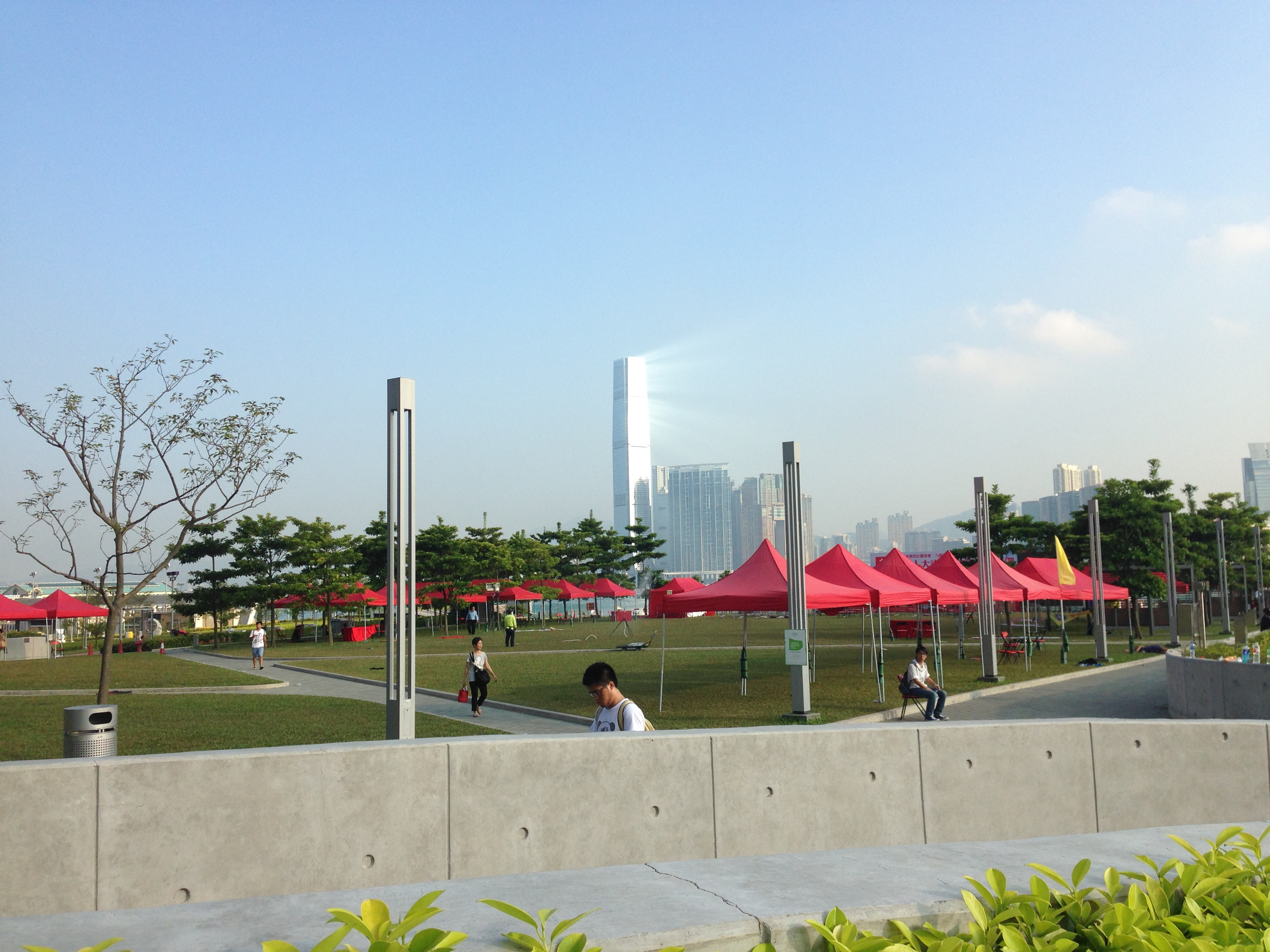
Tamar Park with the installations for the celebrations of the People’s Republic of China (photo taken on Sunday morning).
On the same day the students were told that they were no longer allowed to use Tamar Park, the large grass area underneath the government complex with its beautiful view over the waterfront as a pro-CCP organization was given priority access by the Leisure and Cultural Services Department despite the low number of expected guests [EJInsight].
This just added to the notion among the protesters that they are systematically being deprived of their right to protest. The Civic Party was already denied permission to use Victoria Park as a starting ground for their planned October 1st rally in fear that such a rally could lead to the start of Occupy Central. It seemed that whenever a pro-democracy group wanted to hold a protest a pro-CCP organization had just miraculously showed up the day before to celebrate national unity/harmony/whatever with a busload of elderly citizens. Other public areas that have been the grounds of previous notable protests had already been sealed off much more permanently a long time before, such as the space underneath HSBC in Central or “Civic Square” between the entrances to Legislative Council and the Hong Kong Central Government Offices (CGO). Even the annual march on July 1 was being pushed onto just two lanes, even when police was no longer able to keep the other two lanes open due to the heavy influx of new protesters joining from all sides.
The government made it its core strategy to deprive protesters of public space, and this is key to understanding the blockade of roads after September 28.
Friday, 26 September 2014
Even though the secondary students were supposed to join the strike, few did and the turnout in the afternoon of Friday was very unsatisfactory for the organizers. The protesters were jammed into one lane of Tim Mei Avenue, from where few could see or follow the many speeches by students and ex-students, despite there being a few speakers and screens to relay the messages and pictures. Those in the periphery couldn’t follow the event and many left. I estimate that there were not more than 4,000 people present towards the end of the evening.
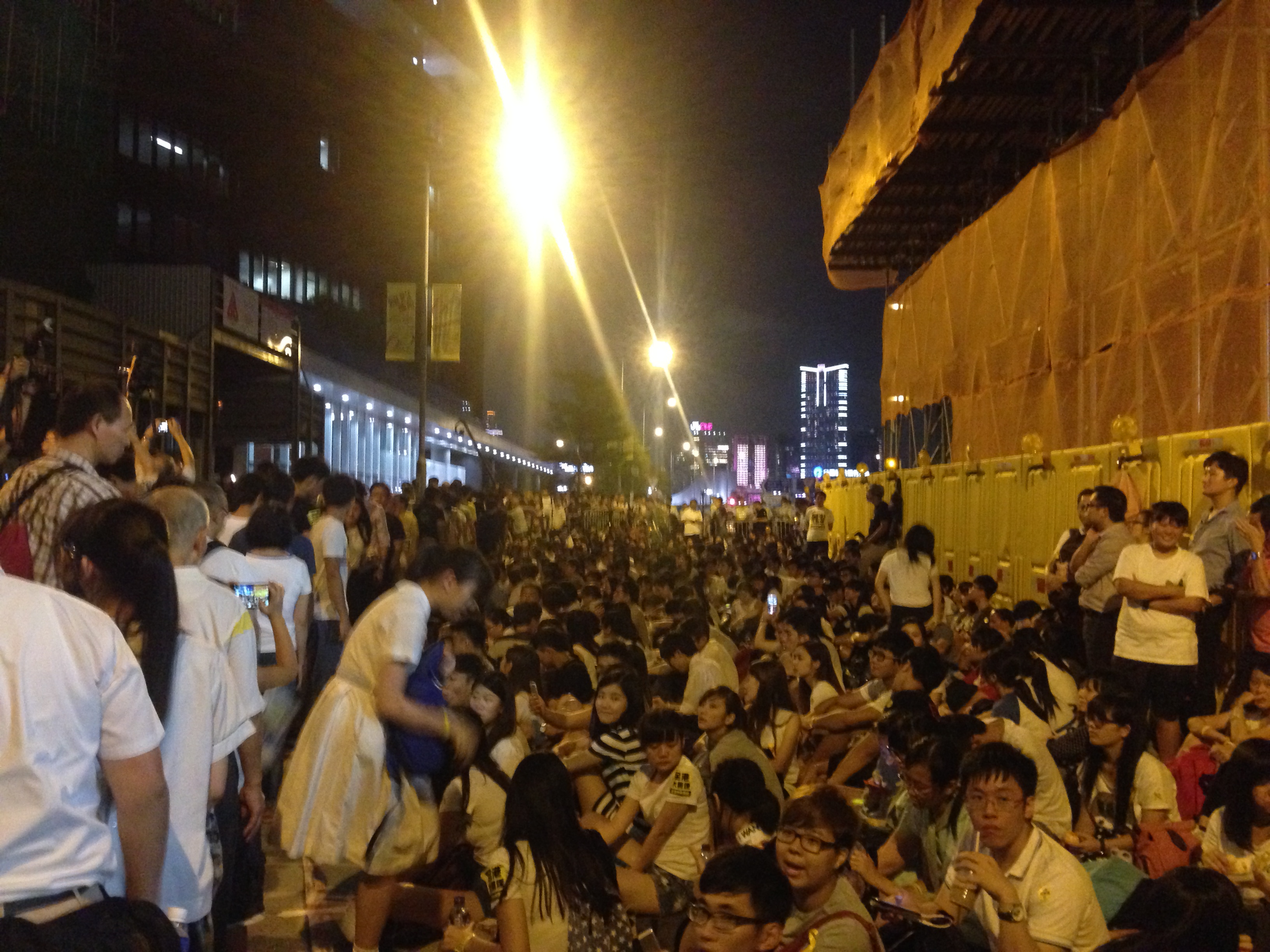
Students being cramped into a single lane on Tim Mei Avenue shortly before the occupation of Civic Square.
When Joshua Wong gave his closing speech at around 22:20 many people had already left. Towards the end of the speech there was sudden nervousness in his voice while he was continuing his speech. It’s clear to me that he knew what the plan was, but it’s unclear to me as whether at this point the plan was already being carried out or this was just the start. About a minute later (22:27) some students had managed to climb into Civic Square, likely by gaining access through LegCo rather than climbing directly from Tim Mei Avenue. They opened the gates from within and students streamed inside while others climbed the fence regardless. Many were hesitant to enter Civic Square even when its gates where wide open. Not even the drive way outside it, which connects the LegCo car park with Tim Mei Avenue saw a large influx of people.
It took Police about 5 minutes to receive orders about how to deal with the situation, but after this short time of perplexity pepper spray was already used in masses inside Civic Square and the square was sealed off again. The Vice News teams was one of the very few international news teams on the scene, and unfortunately got trapped inside Civic Square for about six hours and missed most of what was going on in that time.
Larry Salibra was able to capture a video of the full event:
[youtube https://www.youtube.com/watch?v=51K84Fc31EQ]
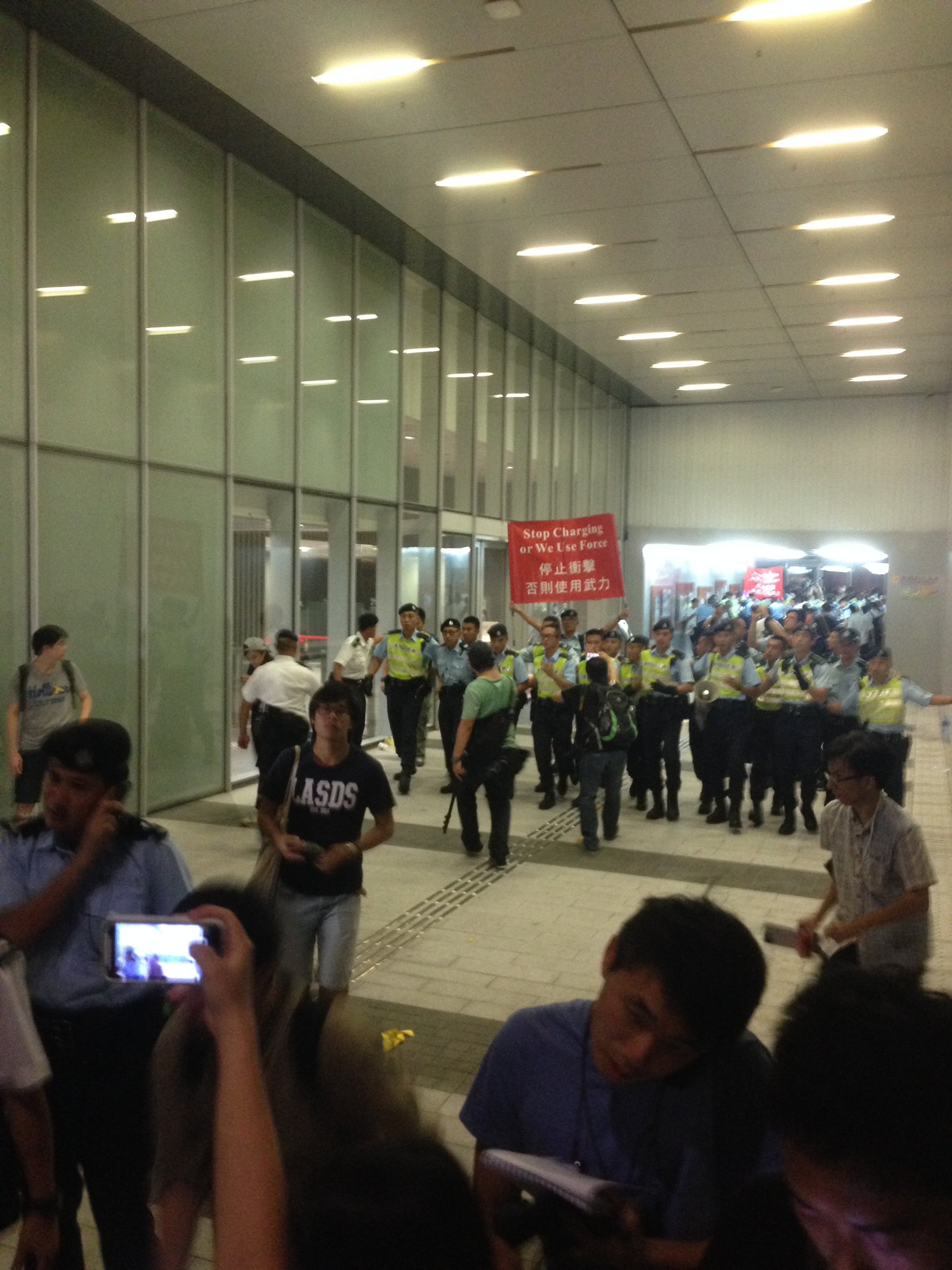
Police attempt to push back protesters out of LegCo entrance using the threat of force.
At about 22:45 ambulances had arrived in the area to evacuate the few injured protesters and officers from inside Civic Square. This proved to be difficult as police still expected students to enter the square and were hesitant to open the gates. Students held hands to form chains to let ambulances through, although they faced no opposition from anyone. I saw four people being brought out of Civic Square on stretchers, at least one with a uniform. I do not know what their injuries where and what happened to them.
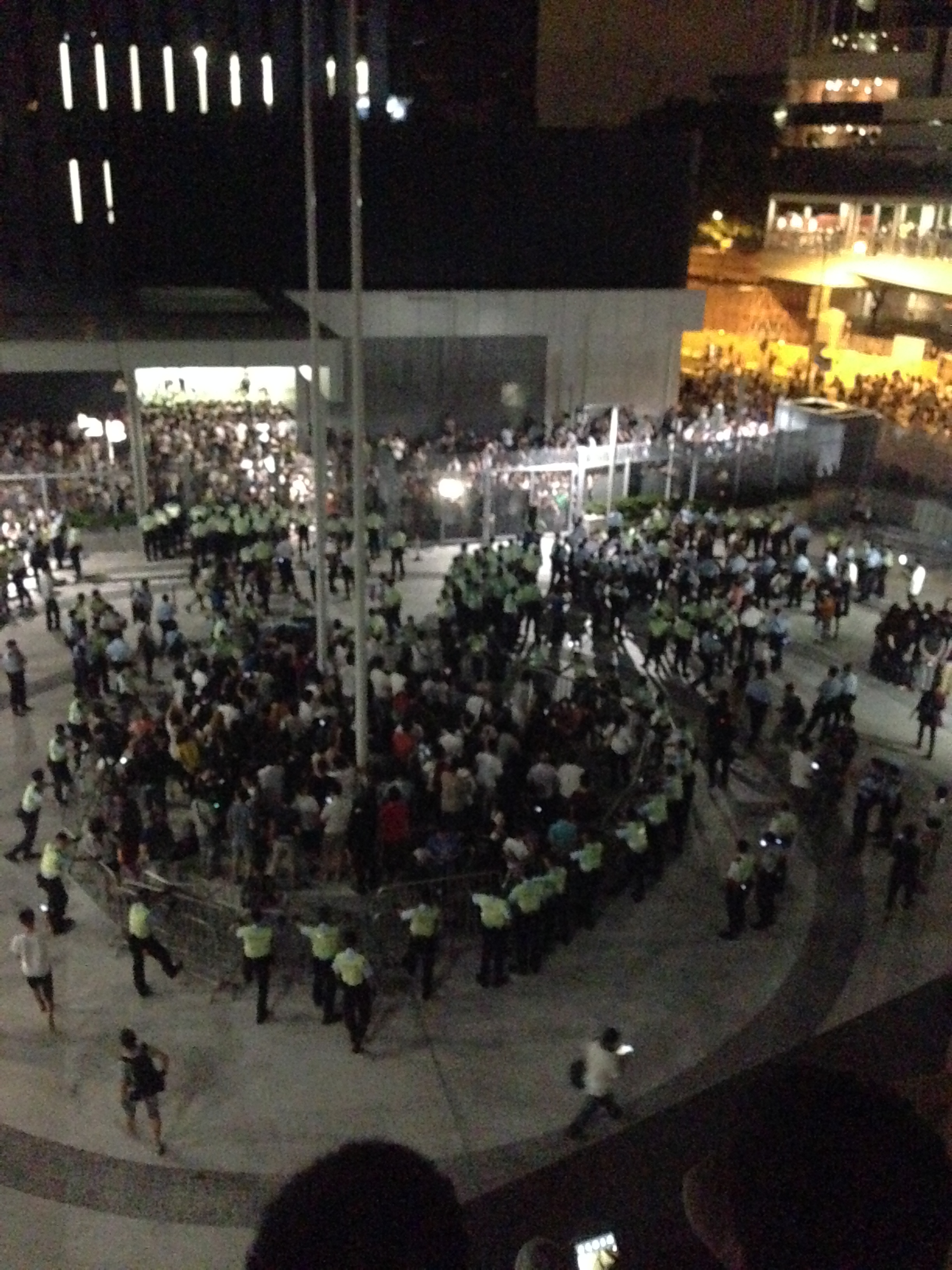
The occupied CIvic Square was the center of attention, but not the center of action.
By midnight the situation had cooled down a bit, with police reforming at the Southern end of Tim Mei Avenue, after having had to retreat completely from this street. Student were already seizing the opportunity to carry around barriers, although clearly without any experience or clear objective. But students were already back then very determined to stay the night there, stocking up on McDonald’s, KFC and water at the nearby Admiralty Station, having arrived at the protest unprepared for an ‘occupation’.
At around 1:00 in the morning the crowds seemed to have gained in numbers and they were blocking entrances to the government offices wherever they could. It must have been slightly humiliating for officers not being able to freely enter and leave the area around the CGO [See a good video here]. Some were even reported to be forced to pee in bottles, as they were unable to leave their post.
Also around that time did the first vans arrive with resources. They were able to unload their goods under the supervision of the police. Among the supplies was almost exclusively water and snacks as protesters had not yet figured out how to protect themselves from pepper spray.
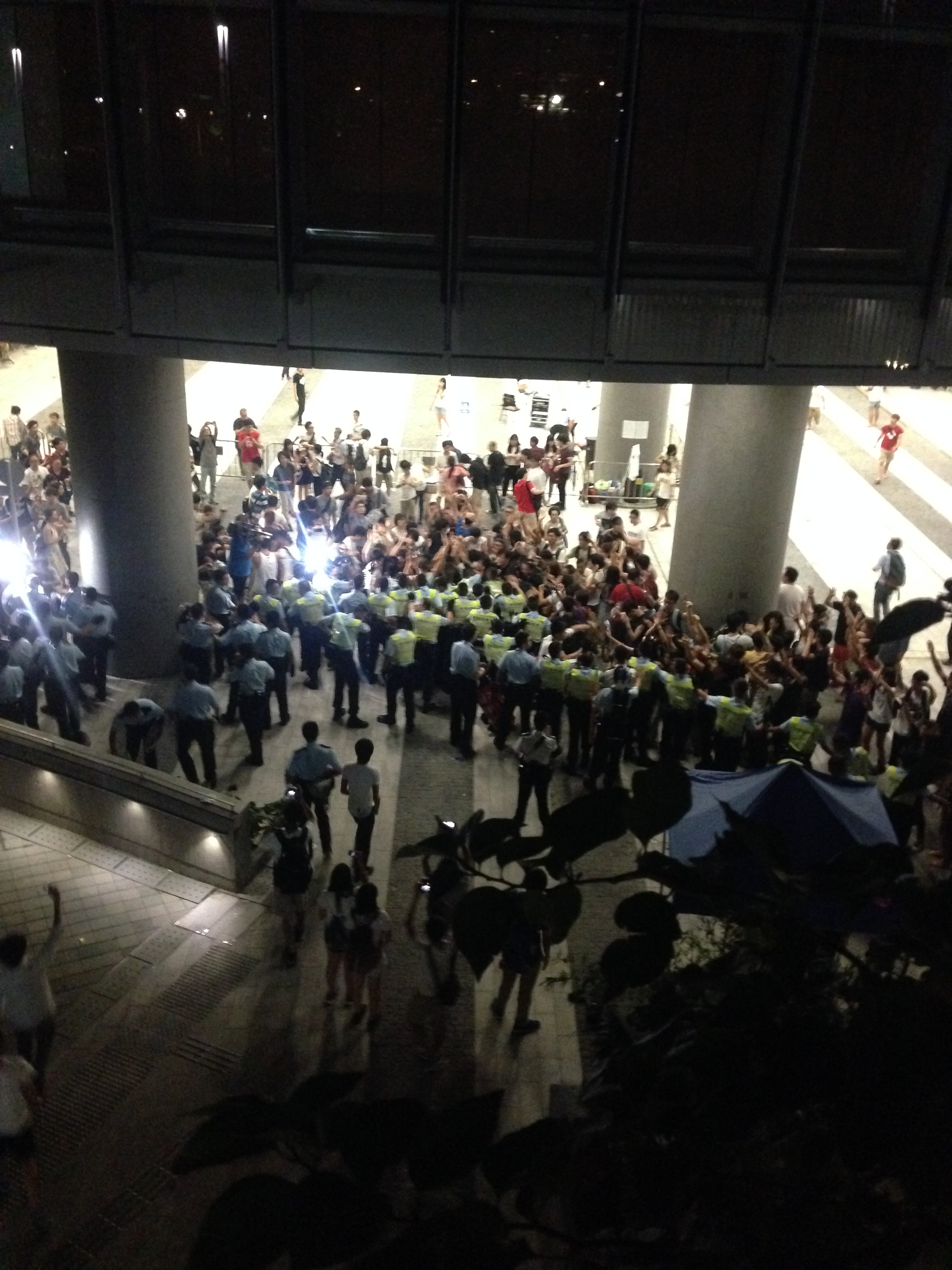
Police try to charge through to a side entrance of LegCo.
It seemed that only slowly did students realize how much power they had over the police, and they grew more confident with each time they were able to prevent police from entering or leaving an area. The picture above shows a group of about 100 officers, some with riot shields who try to gain access to a back entrance of LegCo. They managed to get through only after using pepper spray and violently pushing through the crowds with their shield, and yet the crowd is only slightly larger then them. The entrance they secured remained unusable to the police throughout the night, though.
[youtube https://www.youtube.com/watch?v=FO8WkMMn4yk]
At 2:00 the fear of the police clearing the area started to make the rounds, despite any specific warnings from the police. Officers were still wearing their ordinary uniforms but were already equipped with small round riot shields. Protesters were randomly gathering barricades and securing the roundabout at Lung Wui Road. Ironically the barricades were left by the police to prevent exactly the opposite, to stop protesters from entering.
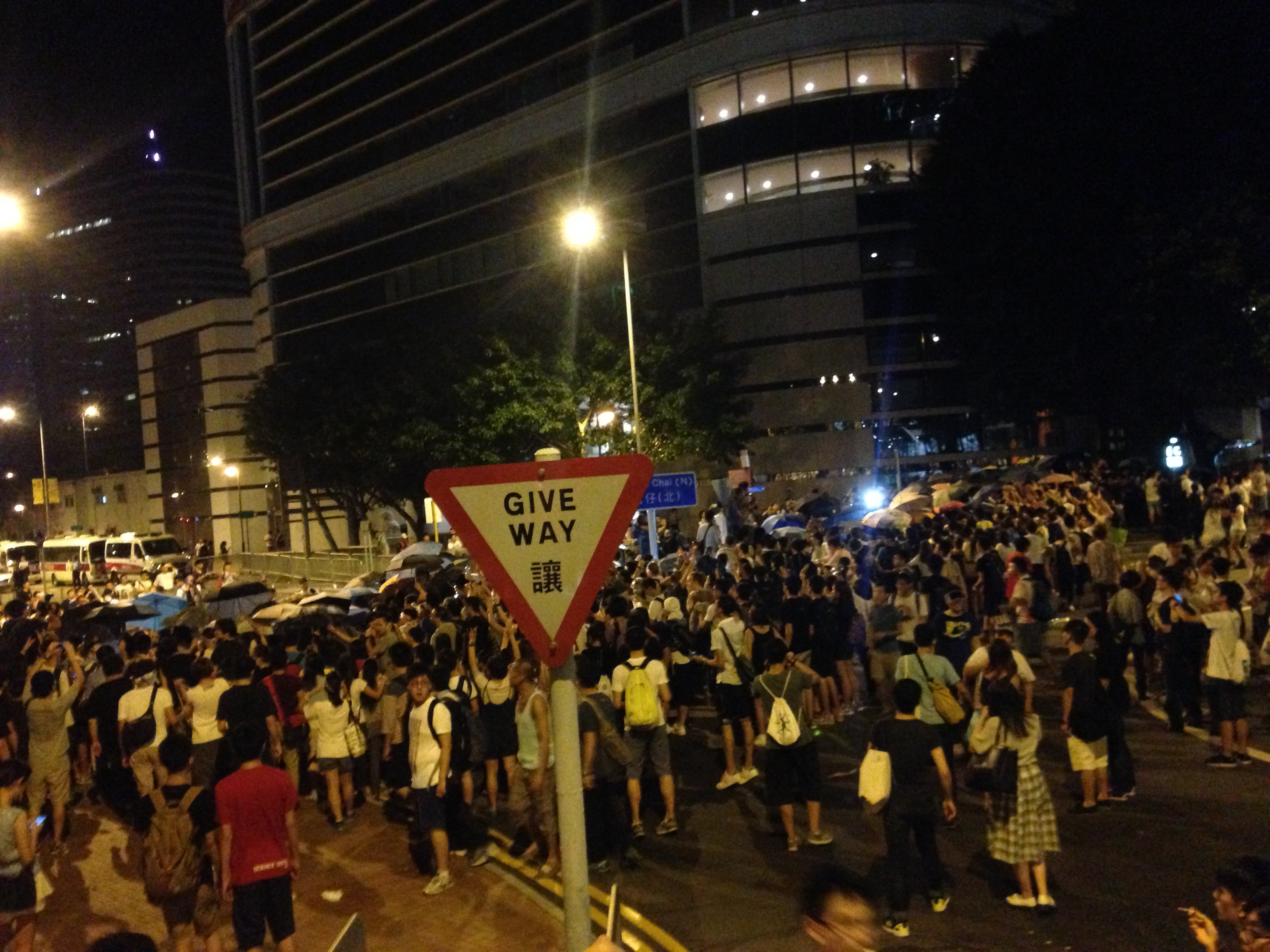
Police trying to clear Lung Wui Road for the first time.
At 2:15 police for the first time tried to clear Lung Wui Road. They disassembled the barricades as quickly as they had been erected but faced a determined and large crowd that was not willing to move a single inch. This was also the first time that umbrellas were seen at the protests as a means of defense against pepper spray. While pepper spray was still widely used by the police when they charged, it no longer had the desired effect of dispersing the crowd. The few protesters that were nonetheless hit were easily able to go towards the roundabout for first aid and be replaced by another student from the back. The police assaulted the crowd in intervals of about 60-20 minutes from then on, each time charging students for about 10-15 minutes. Students didn’t budge a single inch.
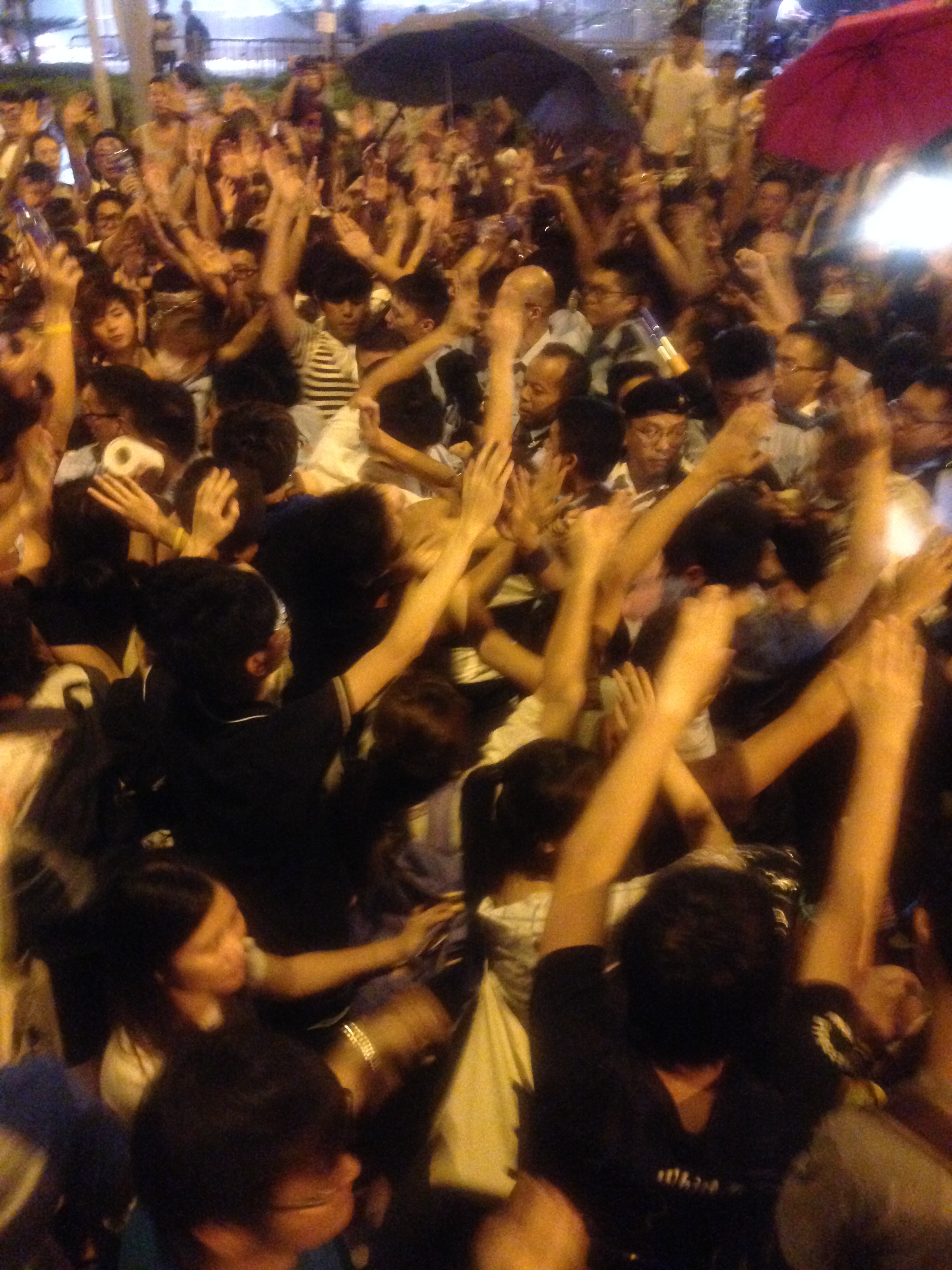
Students surround officers who want to get through to their colleagues.
Meanwhile police still tried to regain access to the buildings of CGO to change shifts of the officers who had been there since the late afternoon. In a small group and with a lot of pepper spray they were able to eventually make their way through, but it must have been very humiliating. The officers who were leaving duty were met with mocking applause but allowed to leave.
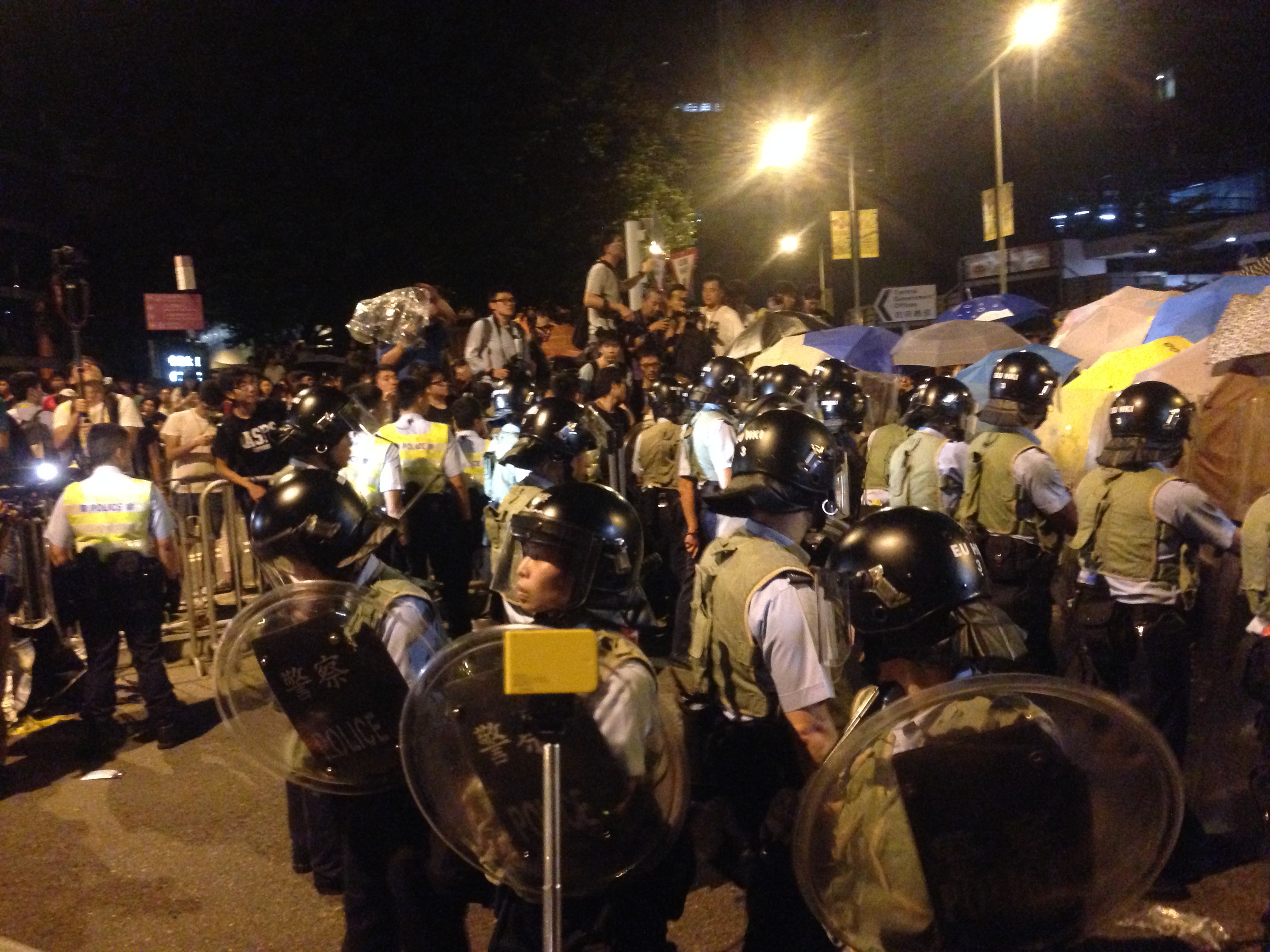
Police trying to clear Lung Wui a second time.
At 3:15 was the second time that police tried to clear Lung Wui Road from the Eastern side, this time with helmets and additional vests (what for?). At the next standoff at about 3:40 police were already equipped with larger shields, charging both from the Eastern side of Lung Wui Road as well as the Northern and Southern Side of Tim Mei Avenue, but curiously never at the same time. Unlike at other standoffs with police there were no negotiations, understandable given that police had arrested all leaders of the student groups.
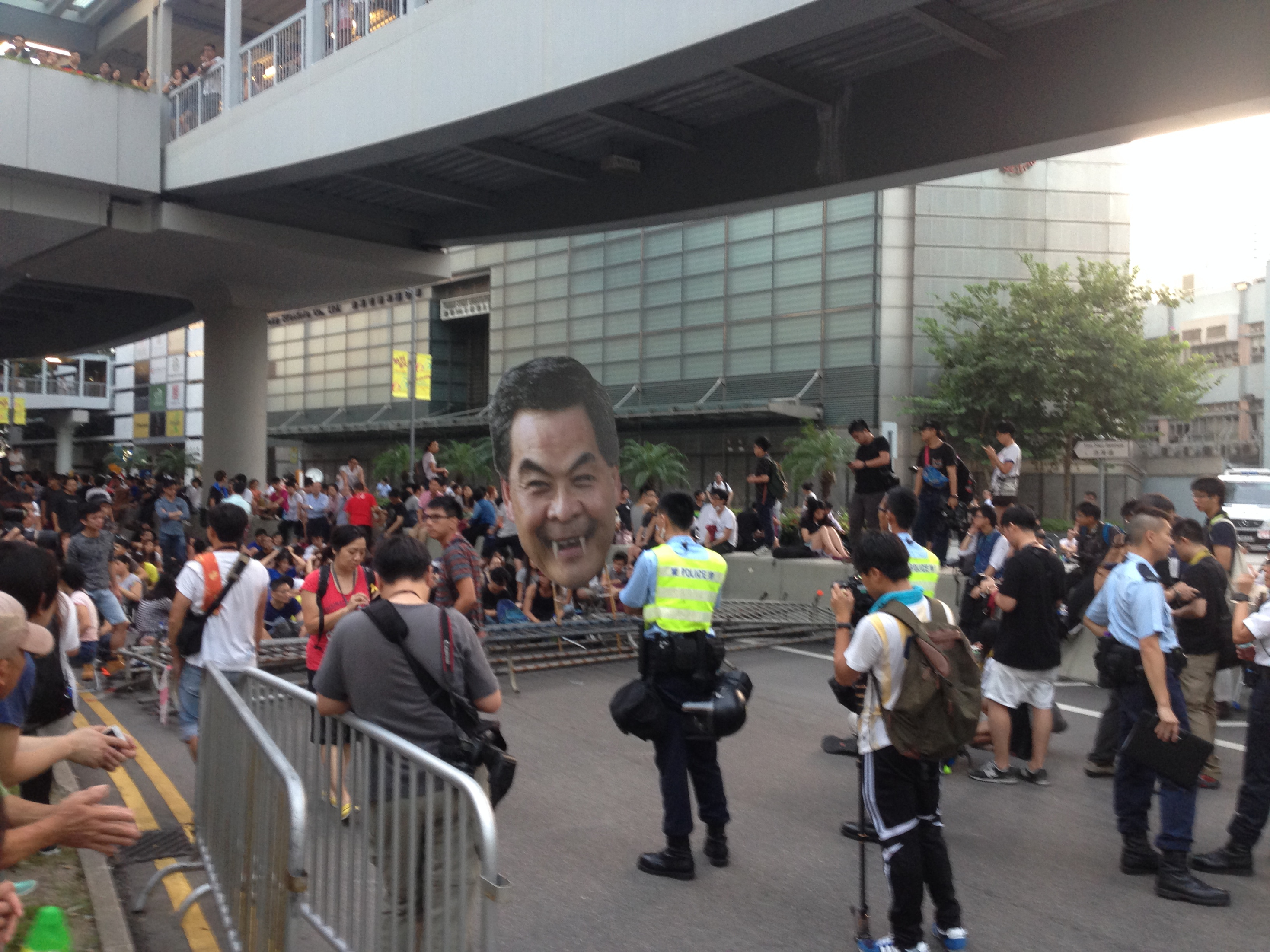
Students after a long night of standoffs.
Only at about 5:00 had things cooled down enough so that students dared to sit down again. By now students were widely using and sharing tips on umbrellas, foil and the proper way to rinse eyes. At around 6:30 most students were still present but were no longer facing, or rather directly confronting police. Civic Square was almost entirely cleared now of protesters. It is remarkable that it took over 8h to clear the square, despite there being only a tenth of the participants of the July 2 sit in on Chater Road, but it might easily have something to do with police not being able to enter and exit the area during the long standoffs with students in the area around it.
Saturday, 27 September 2014
During the day of Saturday the number of protesters had been reduced drastically, but police did not attempt to retake the area on Tim Mei Avenue and Lung Wui Road. In the evening however there were far more people around CGO, at my estimate at least ten-fold (~50,000). Police was originally keen on standing their lines on Lung Wui Road, but soon had to retreat to Fenwick Pier as they found themselves surrounded by protesters.
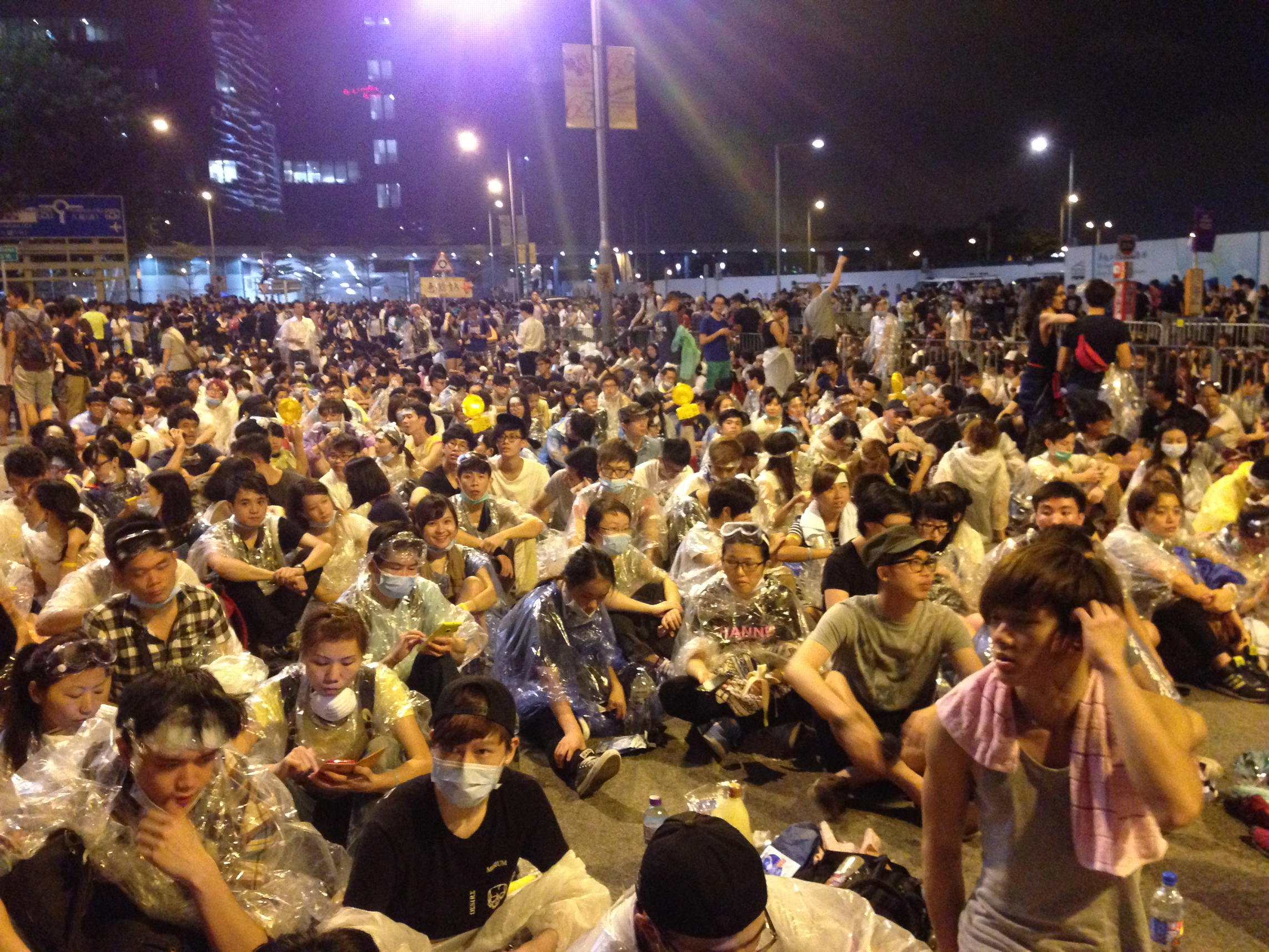
Students prepared to face police
Many students had used the day to stock up on supplies, they were now wearing rain coats, masks, goggles, had snacks, water and umbrellas with them. Some even brought gasoline powered generators for mobile phone charging stations.
These were students who came to this event with the knowledge that they would risk being assaulted with pepper spray and eventually detained. But they did not come to show aggression. Many specifically said that they are not angry, they just want to stand their ground and have their voices heard. And they insisted on their right to peaceful protest.
At 1:40 the public heads of Occupy Central had joined the protest and officially started their campaign, two days ahead of the proposed start on National Day. This sparked a lot of controversy among the students, but debate remained civil and calm. Student leaders emphasized that Benny Tai was in no way in charge of anything, and that this was still a student led protest. For many it was even relieving to finally see the official start of Occupy Central, as the event had for many been difficult to imagine, and yet it had been in everyone’s head for the past months.
Meanwhile other groups had started their own protests, most notably Civic Passion on the other side of Harcourt Road, who take a clearer stance on opposing the Communist Party and emphasizing the unique identity of Hong Kong People.
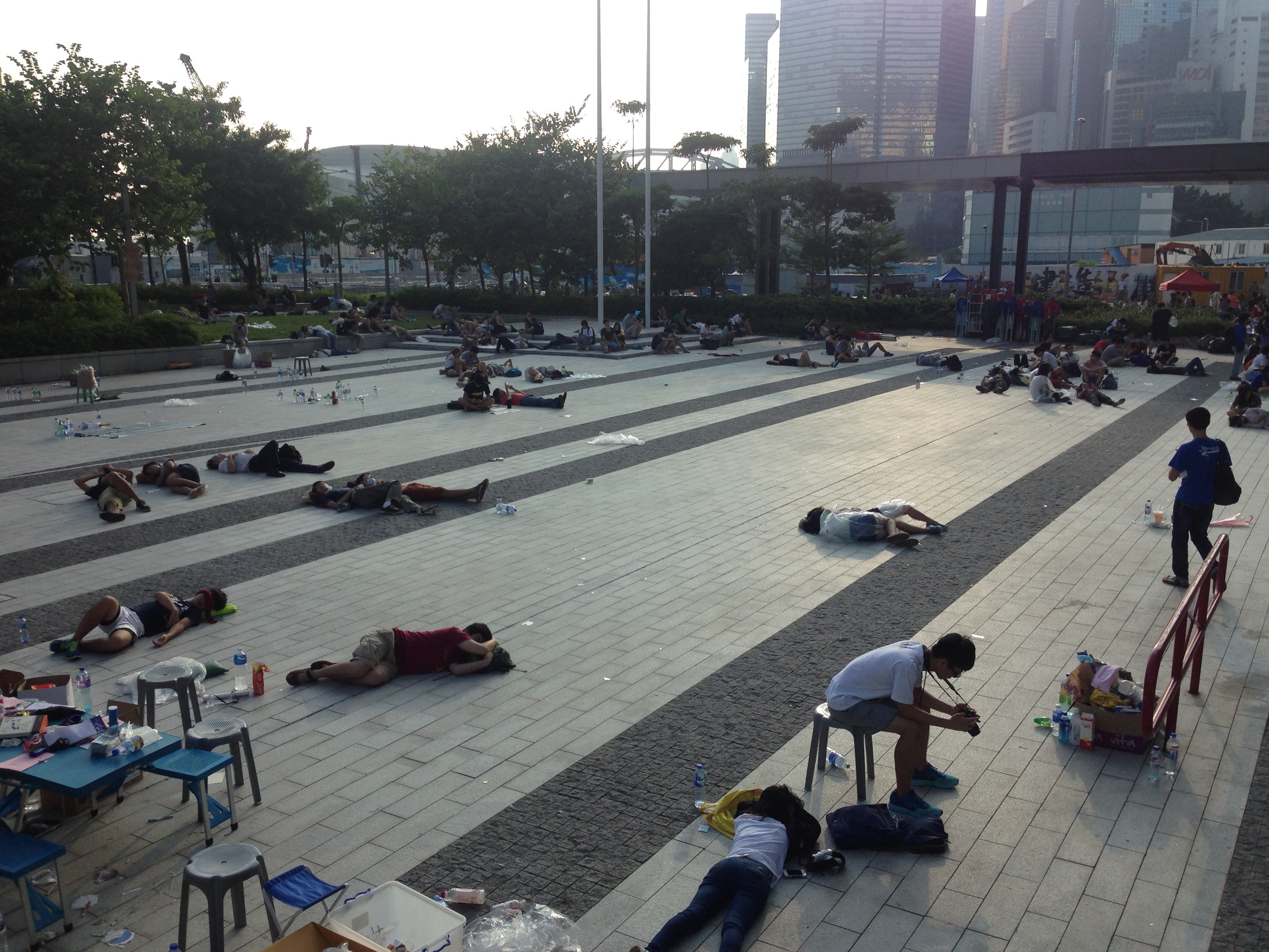
Students sleeping outside LegCo after a long night of fear of police.
Despite heavy police presence there were no attempts to clean the area that night, and many people left via Red Minibus Route from Admiralty to Mong Kok and elsewhere. By 8:00 however the crowd was still noticeably larger than it ever was the day before, with everyone determined to keep the space.
Sunday, 28 September 2014
Throughout Sunday protesters further kept stocking up on supplies, determined to rejoin the movement in the afternoon. This time police tried to block access to Tim Mei Avenue as well as some exits of Admiralty MTR. I doubt this deterred anybody from showing up at the protests. Being deprived of their public space to protest, students and probably most of all the people from Civic Passion decided to regain public space by occupying first Connaught Road/Harcourt Road, then Queensway (and with it Queen’s Road Central and Hennessy Road).
After the second round of tear gas had been fired outside Tim Mei Avenue that afternoon students fled east and decided to occupy Causeway Bay after briefly seeking shelter at the Wan Chai Arts Centre. Mong Kok was occupied shortly after.
In my opinion the blockade of vital roads in Kowloon and the Island was an effect of the government bit by bit depriving its citizens of their right to protest by denying them public space. I’m not sure if it could have been resolved by reverting this process, but the tear gas and violence certainly didn’t help.
The struggle for Universal Suffrage is certainly the motivating theme of the Umbrella Movement, but with adequate places and opportunities to protest this cause the gigantic and lengthy blockade would unlikely have happened. Occupy Central would never have seen this kind of turnout. They expected 10,000 people and hoped for double that, yet 20 to 40 times that amount of people took part in blocking the roads around National Day.
